 | | | 

Solar wind
speed: 395.3 km/sec
density: 2.0 protons/cm3
explanation | more data
Updated: Today at 2345 UT 
X-ray Solar Flares
6-hr max: A9 2039 UT Jan07
24-hr: B1 0306 UT Jan07
explanation | more data
Updated: Today at: 2300 UT 


Daily Sun: 07 Jan 20 

Decaying sunspot AR2755 has a reversed magnetic polarity that identifies it as a member of new Solar Cycle 25. Credit: SDO/HMI



Sunspot number: 11
What is the sunspot number?
Updated 07 Jan 2020Spotless Days
Current Stretch: 0 days
2020 total: 0 days (0%)
2019 total: 281 days (77%)
2018 total: 221 days (61%)
2017 total: 104 days (28%)
2016 total: 32 days (9%)
2015 total: 0 days (0%)
2014 total: 1 day (<1%)
2013 total: 0 days (0%)
2012 total: 0 days (0%)
2011 total: 2 days (<1%)
2010 total: 51 days (14%)
2009 total: 260 days (71%)
2008 total: 268 days (73%)
2007 total: 152 days (42%)
2006 total: 70 days (19%)
Updated 07 Jan 2020Thermosphere Climate Index
today: 2.81x1010 W Cold
Max: 49.4x1010 W Hot (10/1957)
Min: 2.05x1010 W Cold (02/2009)
explanation | more data: gfx, txt
Updated 07 Jan 2020 The Radio Sun
10.7 cm flux: 71 sfu
explanation | more data
Updated 07 Jan 2020 

Cosmic Rays Solar minimum is underway. The sun's magnetic field is weak, allowing extra cosmic rays into the solar system. Neutron counts from the University of Oulu's Sodankyla Geophysical Observatory show that cosmic rays reaching Earth in 2019 are near a Space Age peak.
Oulu Neutron Counts
Percentages of the Space Age average:
today: +8.9% High
7-day change: -0.7%
Max: +11.7% Very High (12/2009)
Min: -32.1% Very Low (06/1991)
explanation | more data
Updated 07 Jan 2020 @ 1800 UT 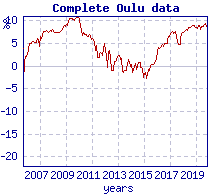


 Current Auroral Oval: Current Auroral Oval:

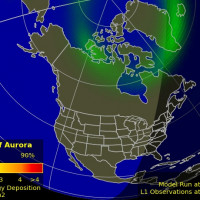

Switch to: Europe, USA, New Zealand, Antarctica
Credit: NOAA/Ovation 


Planetary K-index
Now: Kp= 2 quiet
24-hr max: Kp= 2 quiet
explanation | more data

Interplanetary Mag. Field
Btotal: 2.8 nT
Bz: -1.2 nT south
more data: ACE, DSCOVR
Updated: Today at 2346 UT 


Coronal Holes: 07 Jan 20 


Solar wind flowing from this minor coronal hole could reach Earth on Jan 8th or (more likely) Jan 9th. Credit: SDO/AIA
 
Noctilucent Clouds The southern hemisphere season for noctilucent clouds began on Nov. 15th--the earliest start in recorded history. Check here for daily images from NASA's AIM spacecraft. 


Switch view: Europe, USA, Asia, Polar 
Updated at: 01-07-2020 15:55:03 UT 


SPACE WEATHER
NOAA Forecasts | 
| 

Updated at: 2020 Jan 07 2200 UTC 
FLARE | 0-24 hr | 24-48 hr | CLASS M | 01 % | 01 % | CLASS X | 01 % | 01 % | 


Geomagnetic Storms:
Probabilities for significant disturbances in Earth's magnetic field are given for three activity levels: active, minor storm, severe storm 
Updated at: 2020 Jan 07 2200 UTC 
Mid-latitudes | 0-24 hr | 24-48 hr | ACTIVE | 20 % | 20 % | MINOR | 05 % | 05 % | SEVERE | 01 % | 01 % | 
High latitudes | 0-24 hr | 24-48 hr | ACTIVE | 15 % | 15 % | MINOR | 30 % | 30 % | SEVERE | 25 % | 25 % | | | |  | | | | | | | | | | | 
Marianne’s Arctic tours: Operating in small groups of 7 to 14 persons--all needs supplied for safety, comfort and pleasure. Night & day photography or non-photographic landscape - wildlife tours. Click for details! | | 
| 
PENUMBRAL LUNAR ECLIPSE: When the full Moon rises on Friday evening, Jan. 10th, you might notice something odd--a pale shadow darkening the Moon's southern hemisphere. That is the shadow of Earth, and if you can see it, you've spotted a penumbral lunar eclipse. Friday's eclipse will be visible from the Asian side of Earth, but not from the Americas. Watch Larry Koehn's eclipse movie for more information. ELECTRICITY SURGES THROUGH THE SOIL OF NORWAY: Yesterday, Jan. 6th, something unexpected happened in the soil of northern Norway. "Electrical currents started flowing," reports Rob Stammes, who monitors ground currents at the Polarlightcenter geophysical observatory in Lofoten. This chart recording shows the sudden surge around 1930 UT: 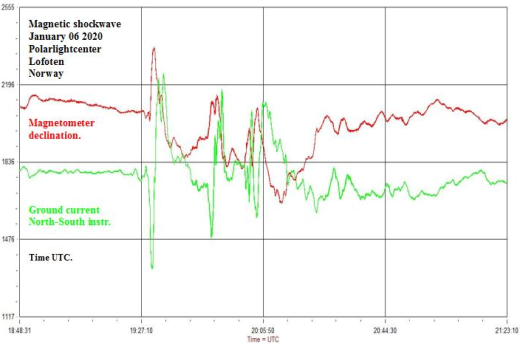
"It seemed to be some kind of shockwave," says Stammes. "My instruments detected a sudden, strong variation in both ground currents and our local magnetic field. It really was a surprise." NASA's ACE spacecraft detected something as well. About 15 minutes before the disturbance in Norway, the interplanetary magnetic field (IMF) near Earth abruptly swung around 180 degrees, and the solar wind density jumped more than 5-fold. Earth may have crossed through a fold in the heliospheric current sheet--a giant, wavy membrane of electrical current rippling through the solar system. Such crossings can cause these kind of effects. While currents flowed through the ground, auroras filled the sky. Rayann Elzein photographed the corresponding outburst of lights from Utsjoki, Finland: 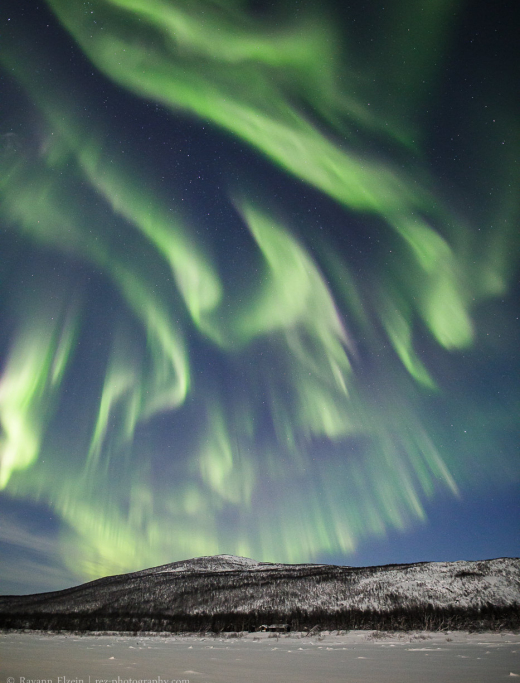
"What a surprise!" says Elzein. "The auroras were sudden and dynamic, with fast-moving green needles and several purple fringes!" The auroras and ground currents were caused by the same thing: Rapidly changing magnetic fields. High above Earth's surface, magnetic vibrations shook loose energetic particles, which rained down on the upper atmosphere, creating auroras where they struck. Just below Earth's surface, magnetic vibrations caused currents to flow, triggering Rob Stammes' ground sensors. "We couldn't see the auroras in northern Norway because of cloud cover," says Stammes, a little ruefully. "We had to be satisfied with the electricity underfoot." Realtime Aurora Photo Gallery
Free: Spaceweather.com Newsletter SILK SPACE ROSE FOR VALENTINE'S DAY: Valentine's Day is coming, and nothing says "I love you" like a silk rose from the edge of space. On Jan. 4, 2020, the students of Earth to Sky Calculus launched their first cosmic ray balloon of 2020. This rose went along for the ride, traveling 111,424 feet above the Sierra Nevada mountains of central California: 
You can have it for $116.65. The students are selling Valentine's space roses to support their cosmic ray ballooning program. Each silk bloom comes with a greeting card showing the rose in flight and telling the story of its journey to the stratosphere and back again. Also included are the glass dome, wooden base, and an LED light kit to make your rose glisten like the stars. Far Out Gifts: Earth to Sky Store
All sales support hands-on STEM education
Realtime Spaceweather Photo Gallery
Free: Spaceweather.com Newsletter


Every night, a network of NASA all-sky cameras scans the skies above the United States for meteoritic fireballs. Automated software maintained by NASA's Meteoroid Environment Office calculates their orbits, velocity, penetration depth in Earth's atmosphere and many other characteristics. Daily results are presented here on Spaceweather.com. On Jan. 07, 2020, the network reported 6 fireballs.
(5 sporadics, 1 Quadrantid) 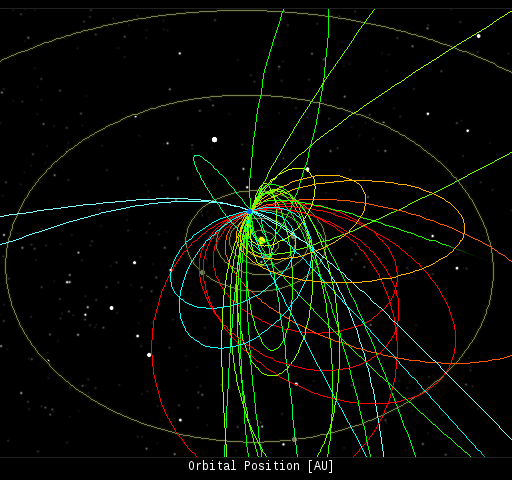 In this diagram of the inner solar system, all of the fireball orbits intersect at a single point--Earth. The orbits are color-coded by velocity, from slow (red) to fast (blue). [Larger image] [movies] 

Potentially Hazardous Asteroids (PHAs) are space rocks larger than approximately 100m that can come closer to Earth than 0.05 AU. None of the known PHAs is on a collision course with our planet, although astronomers are finding new ones all the time. 
On January 7, 2020 there were 2018 potentially hazardous asteroids.

Recent & Upcoming Earth-asteroid encounters: 
Notes: LD means "Lunar Distance." 1 LD = 384,401 km, the distance between Earth and the Moon. 1 LD also equals 0.00256 AU. MAG is the visual magnitude of the asteroid on the date of closest approach. 
| | Cosmic Rays in the Atmosphere | 
SOMETHING NEW! We have developed a new predictive model of aviation radiation. It's called E-RAD--short for Empirical RADiation model. We are constantly flying radiation sensors onboard airplanes over the US and and around the world, so far collecting more than 22,000 gps-tagged radiation measurements. Using this unique dataset, we can predict the dosage on any flight over the USA with an error no worse than 15%. E-RAD lets us do something new: Every day we monitor approximately 1400 flights criss-crossing the 10 busiest routes in the continental USA. Typically, this includes more than 80,000 passengers per day. E-RAD calculates the radiation exposure for every single flight. The Hot Flights Table is a daily summary of these calculations. It shows the 5 charter flights with the highest dose rates; the 5 commercial flights with the highest dose rates; 5 commercial flights with near-average dose rates; and the 5 commercial flights with the lowest dose rates. Passengers typically experience dose rates that are 20 to 70 times higher than natural radiation at sea level. To measure radiation on airplanes, we use the same sensors we fly to the stratosphere onboard Earth to Sky Calculus cosmic ray balloons: neutron bubble chambers and X-ray/gamma-ray Geiger tubes sensitive to energies between 10 keV and 20 MeV. These energies span the range of medical X-ray machines and airport security scanners. Column definitions: (1) The flight number; (2) The maximum dose rate during the flight, expressed in units of natural radiation at sea level; (3) The maximum altitude of the plane in feet above sea level; (4) Departure city; (5) Arrival city; (6) Duration of the flight. SPACE WEATHER BALLOON DATA: Approximately once a week, Spaceweather.com and the students of Earth to Sky Calculus fly space weather balloons to the stratosphere over California. These balloons are equipped with radiation sensors that detect cosmic rays, a surprisingly "down to Earth" form of space weather. Cosmic rays can seed clouds, trigger lightning, and penetrate commercial airplanes. Furthermore, there are studies ( #1, #2, #3, #4) linking cosmic rays with cardiac arrhythmias and sudden cardiac death in the general population. Our latest measurements show that cosmic rays are intensifying, with an increase of more than 18% since 2015: 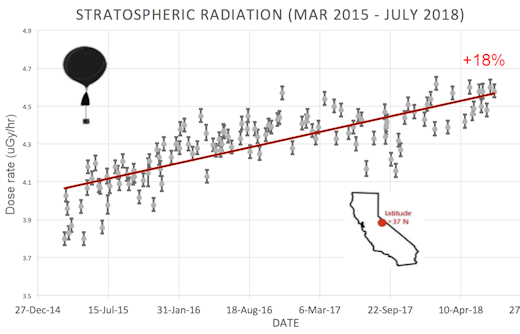
The data points in the graph above correspond to the peak of the Reneger-Pfotzer maximum, which lies about 67,000 feet above central California. When cosmic rays crash into Earth's atmosphere, they produce a spray of secondary particles that is most intense at the entrance to the stratosphere. Physicists Eric Reneger and Georg Pfotzer discovered the maximum using balloons in the 1930s and it is what we are measuring today. En route to the stratosphere, our sensors also pass through aviation altitudes: 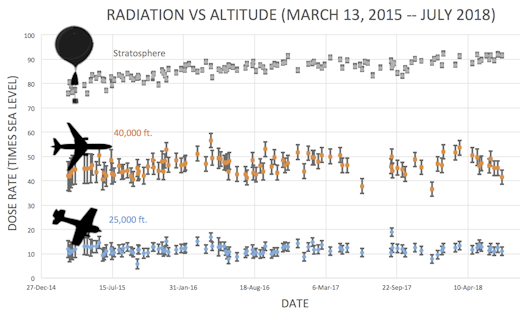
In this plot, dose rates are expessed as multiples of sea level. For instance, we see that boarding a plane that flies at 25,000 feet exposes passengers to dose rates ~10x higher than sea level. At 40,000 feet, the multiplier is closer to 50x. The radiation sensors onboard our helium balloons detect X-rays and gamma-rays in the energy range 10 keV to 20 MeV. These energies span the range of medical X-ray machines and airport security scanners. Why are cosmic rays intensifying? The main reason is the sun. Solar storm clouds such as coronal mass ejections (CMEs) sweep aside cosmic rays when they pass by Earth. During Solar Maximum, CMEs are abundant and cosmic rays are held at bay. Now, however, the solar cycle is swinging toward Solar Minimum, allowing cosmic rays to return. Another reason could be the weakening of Earth's magnetic field, which helps protect us from deep-space radiation. 


| | The official U.S. government space weather bureau | 

| | The first place to look for information about sundogs, pillars, rainbows and related phenomena. | 

| | Researchers call it a "Hubble for the sun." SDO is the most advanced solar observatory ever. | 

| | 3D views of the sun from NASA's Solar and Terrestrial Relations Observatory | 

| | Realtime and archival images of the Sun from SOHO. | 
| | from the NOAA Space Environment Center | 

| | fun to read, but should be taken with a grain of salt! Forecasts looking ahead more than a few days are often wrong. | 
| | from the NOAA Space Environment Center | 
| | the underlying science of space weather | 








 | To find reviews of new online casino sites in the UK try The Casino DB where there are hundreds of online casino reviews complete with bonuses and ratings. Get a bonus when playing at a new casino in the UK. The Genie got you covered! Looking for a new online casino? Try Casimpo the new site dedicated to making online casino simple and easy for all. | 
| | These links help Spaceweather.com stay online. Thank you to our supporters! | 
| | | | | | | | |  | |